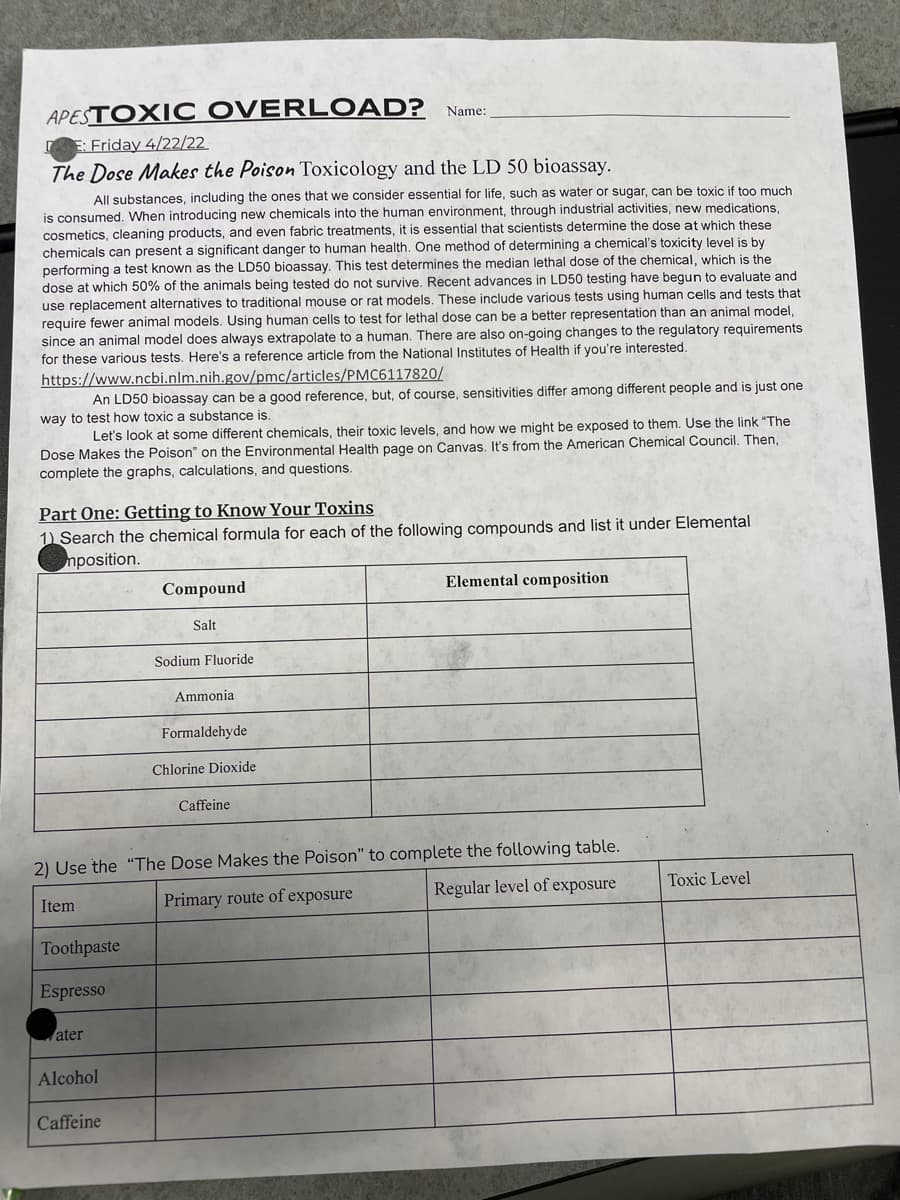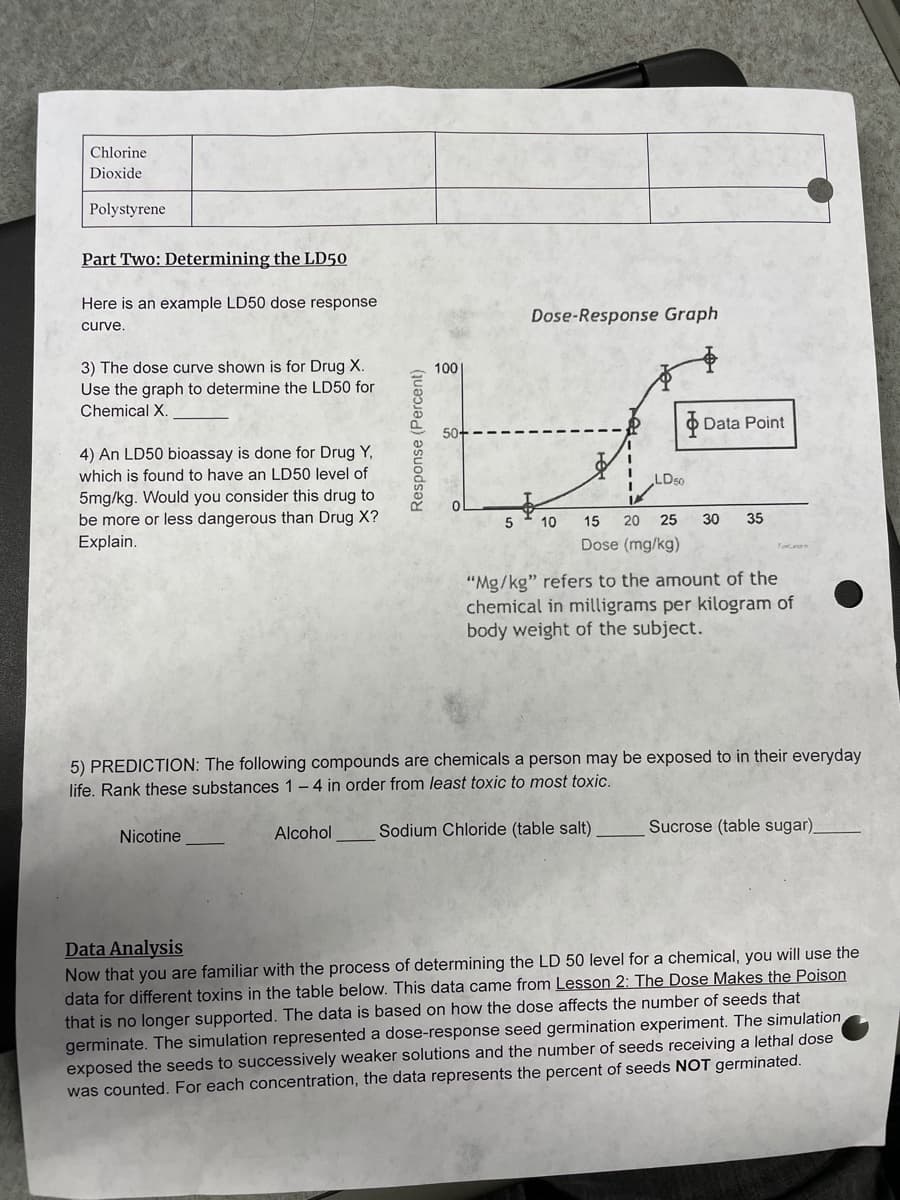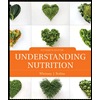APESTOXIC OVERL OAD? Name: E: Friday 4/22/22 The Dose Makes the Poison Toxicology and the LD 50 bioassay. All substances, including the ones that we consider essential for life, such as water or sugar, can be toxic if too much is consumed. When introducing new chemicals into the human environment, through industrial activities, new medications, cosmetics, cleaning products, and even fabric treatments, it is essential that scientists determine the dose at which these chemicals can present a significant danger to human health. One method of determining a chemical's toxicity level is by performing a test known as the LD50 bioassay. This test determines the median lethal dose of the chemical, which is the dose at which 50% of the animals being tested do not survive. Recent advances in LD50 testing have begun to evaluate and use replacement alternatives to traditional mouse or rat models. These include various tests using human cells and tests that require fewer animal models. Using human cells to test for lethal dose can be a better representation than an animal model, since an animal model does always extrapolate to a human. There are also on-going changes to the regulatory requirements for these various tests. Here's a reference article from the National Institutes of Health if you're interested. https://www.ncbi.nlm.nih.gov/pmc/articles/PMC6117820/ An LD50 bioassay can be a good reference, but, of course, sensitivities differ among different people and is just one way to test how toxic a substance is. Let's look at some different chemicals, their toxic levels, and how we might be exposed to them. Use the link "The Dose Makes the Poison" on the Environmental Health page on Canvas. It's from the American Chemical Council. Then, complete the graphs, calculations, and questions. Part One: Getting to Know Your Toxins 11 Search the chemical formula for each of the following compounds and list it under Elemental mposition. Compound Elemental composition Salt Sodium Fluoride Ammonia Formaldehyde Chlorine Dioxide Caffeine 2) Use the "The Dose Makes the Poison" to complete the following table. Item Primary route of exposure Regular level of exposure Toxic Level Toothpaste Espresso ater Alcohol Caffeine
APESTOXIC OVERL OAD? Name: E: Friday 4/22/22 The Dose Makes the Poison Toxicology and the LD 50 bioassay. All substances, including the ones that we consider essential for life, such as water or sugar, can be toxic if too much is consumed. When introducing new chemicals into the human environment, through industrial activities, new medications, cosmetics, cleaning products, and even fabric treatments, it is essential that scientists determine the dose at which these chemicals can present a significant danger to human health. One method of determining a chemical's toxicity level is by performing a test known as the LD50 bioassay. This test determines the median lethal dose of the chemical, which is the dose at which 50% of the animals being tested do not survive. Recent advances in LD50 testing have begun to evaluate and use replacement alternatives to traditional mouse or rat models. These include various tests using human cells and tests that require fewer animal models. Using human cells to test for lethal dose can be a better representation than an animal model, since an animal model does always extrapolate to a human. There are also on-going changes to the regulatory requirements for these various tests. Here's a reference article from the National Institutes of Health if you're interested. https://www.ncbi.nlm.nih.gov/pmc/articles/PMC6117820/ An LD50 bioassay can be a good reference, but, of course, sensitivities differ among different people and is just one way to test how toxic a substance is. Let's look at some different chemicals, their toxic levels, and how we might be exposed to them. Use the link "The Dose Makes the Poison" on the Environmental Health page on Canvas. It's from the American Chemical Council. Then, complete the graphs, calculations, and questions. Part One: Getting to Know Your Toxins 11 Search the chemical formula for each of the following compounds and list it under Elemental mposition. Compound Elemental composition Salt Sodium Fluoride Ammonia Formaldehyde Chlorine Dioxide Caffeine 2) Use the "The Dose Makes the Poison" to complete the following table. Item Primary route of exposure Regular level of exposure Toxic Level Toothpaste Espresso ater Alcohol Caffeine
Understanding Nutrition (MindTap Course List)
15th Edition
ISBN:9781337392693
Author:Eleanor Noss Whitney, Sharon Rady Rolfes
Publisher:Eleanor Noss Whitney, Sharon Rady Rolfes
Chapter1: An Overview Of Nutrition
Section: Chapter Questions
Problem 1BCTQ
Related questions
Question
https://www.chemicalsafetyfacts.org/dose-makes-poison-gallery/
This is the link to help out the worksheet. Thank you

Transcribed Image Text:APESTOXI C OVERL OAD?
Name:
DE: Friday 4/22/22
The Dose Makes the Poison Toxicology and the LD 50 bioassay.
All substances, including the ones that we consider essential for life, such as water or sugar, can be toxic if too much
is consumed. When introducing new chemicals into the human environment, through industrial activities, new medications,
cosmetics, cleaning products, and even fabric treatments, it is essential that scientists determine the dose at which these
chemicals can present a significant danger to human health. One method of determining a chemical's toxicity level is by
performing a test known as the LD50 bioassay. This test determines the median lethal dose of the chemical, which is the
dose at which 50% of the animals being tested do not survive. Recent advances in LD50 testing have begun to evaluate and
use replacement alternatives to traditional mouse or rat models. These include various tests using human cells and tests that
require fewer animal models. Using human cells to test for lethal dose can be a better representation than an animal model,
since an animal model does always extrapolate to a human. There are also on-going changes to the regulatory requirements
for these various tests. Here's a reference article from the National Institutes of Health if you're interested.
https://www.ncbi.nlm.nih.gov/pmc/articles/PMC6117820/
An LD50 bioassay can be a good reference, but, of course, sensitivities differ among different people and is just one
way to test how toxic a substance is.
Let's look at some different chemicals, their toxic levels, and how we might be exposed to them. Use the link "The
Dose Makes the Poison" on the Environmental Health page on Canvas. It's from the American Chemical Council. Then,
complete the graphs, calculations, and questions.
Part One: Getting to Know Your Toxins
11 Search the chemical formula for each of the following compounds and list it under Elemental
mposition.
Compound
Elemental composition
Salt
Sodium Fluoride
Ammonia
Formaldehyde
Chlorine Dioxide
Caffeine
2) Use the "The Dose Makes the Poison" to complete the following table.
Item
Primary route of exposure
Regular level of exposure
Toxic Level
Toothpaste
Espresso
ater
Alcohol
Caffeine

Transcribed Image Text:Chlorine
Dioxide
Polystyrene
Part Two: Determining the LD50
Here is an example LD50 dose response
Dose-Response Graph
curve.
3) The dose curve shown is for Drug X.
Use the graph to determine the LD50 for
Chemical X.
100
O Data Point
4) An LD50 bioassay is done for Drug Y,
which is found to have an LD50 level of
LD50
5mg/kg. Would you consider this drug to
be more or less dangerous than Drug X?
Explain.
5
10
15
20
25
30
35
Dose (mg/kg)
Ton
"Mg/kg" refers to the amount of the
chemical in milligrams per kilogram of
body weight of the subject.
5) PREDICTION: The following compounds are chemicals a person may be exposed to in their everyday
life. Rank these substances 1-4 in order from least toxic to most toxic.
Alcohol
Sodium Chloride (table salt)
Sucrose (table sugar)
Nicotine
Data Analysis
Now that you are familiar with the process of determining the LD 50 level for a chemical, you will use the
data for different toxins in the table below. This data came from Lesson 2: The Dose Makes the Poison
that is no longer supported. The data is based on how the dose affects the number of seeds that
germinate. The simulation represented a dose-response seed germination experiment. The simulation
exposed the seeds to successively weaker solutions and the number of seeds receiving a lethal dose
was counted. For each concentration, the data represents the percent of seeds NOT germinated.
Expert Solution
This question has been solved!
Explore an expertly crafted, step-by-step solution for a thorough understanding of key concepts.
This is a popular solution!
Trending now
This is a popular solution!
Step by step
Solved in 4 steps

Knowledge Booster
Learn more about
Need a deep-dive on the concept behind this application? Look no further. Learn more about this topic, biology and related others by exploring similar questions and additional content below.Recommended textbooks for you

Understanding Nutrition (MindTap Course List)
Health & Nutrition
ISBN:
9781337392693
Author:
Eleanor Noss Whitney, Sharon Rady Rolfes
Publisher:
Cengage Learning

Comprehensive Medical Assisting: Administrative a…
Nursing
ISBN:
9781305964792
Author:
Wilburta Q. Lindh, Carol D. Tamparo, Barbara M. Dahl, Julie Morris, Cindy Correa
Publisher:
Cengage Learning


Understanding Nutrition (MindTap Course List)
Health & Nutrition
ISBN:
9781337392693
Author:
Eleanor Noss Whitney, Sharon Rady Rolfes
Publisher:
Cengage Learning

Comprehensive Medical Assisting: Administrative a…
Nursing
ISBN:
9781305964792
Author:
Wilburta Q. Lindh, Carol D. Tamparo, Barbara M. Dahl, Julie Morris, Cindy Correa
Publisher:
Cengage Learning




Essentials of Pharmacology for Health Professions
Nursing
ISBN:
9781305441620
Author:
WOODROW
Publisher:
Cengage